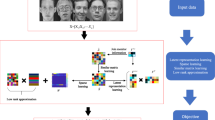Abstract
The classification of hyperspectral image with a paucity of labeled samples is a challenging task. In this paper, we present a discriminant sparse representation (DSR) graph for semi-supervised learning (SSL) to address this problem. For graph-based methods, how to construct a graph among the pixels is the key to a successful classification. Our graph construction method contains two steps. Sparse representation (SR) method is first employed to estimate the probability matrix of the pairwise pixels belonging to the same class, and then this probability matrix is integrated into the SR graph, which can be obtained by solving an ℓ 1 optimization problem, to form a DSR graph. Experiments on Hyperion and AVIRIS hyperspectral data show that our proposed method outperforms state of the art.


Similar content being viewed by others
References
Belkin M, Niyogi P (2003) Laplacian eigenmaps for dimensionality reduction and data representation. Neural Comput 15(6):1373–1396
Belkin M, Niyogi P, Sindhwani V (2006) Manifold regularization: a geometric framework for learning from labeled and unlabeled examples. J Mach Learn Res 7:2399–2434
Camps-Valls G, Bandos Marsheva T, Zhou D (2007) Semi-supervised graph-based hyperspectral image classification. IEEE Trans Geosci Remote Sens 45 (10):3044–3054
Cheng H, Liu Z, Yang J (2009) Sparsity induced similarity measure for label propagation. In: Proceedings of IEEE 12th international conference of computer vision, Kyoto, pp 317–324
Gao Y, Ji R, Cui P, Dai Q, Hua G (2014) Hyperspectral image classification through bilayer graph based learning. IEEE Trans Image Process 23(7):2769–2778
Kim W, Crawford MM (2010) Adaptive classification for hyperspectral image data using manifold regularization kernel machines. IEEE Trans Geosci Remote Sens 48(11):4110–4121
Lunga D, Prasad S, Crawford MM, Ersoy O (2014) Manifold-learning-based feature extraction for classification of hyperspectral data: a review of advances in manifold learning. IEEE Signal Process Mag 31(1):55–66
Roweis ST, Saul LK (2000) Nonlinear dimensionality reduction by locally linear embedding. Science 290(5500):2323–2326
Wang F, Zhang C (2008) Label propagation through linear neighborhoods. IEEE Trans Knowl Data Eng 20(1):55–67
Wang D, Lu H, Xiao Z, Yang MH (2015) Inverse sparse tracker with a locally weighted distance metric. IEEE Trans Image Process 24:2646–2657
Wang D, Lu H, Yang MH (2015) Kernel collaborative face recognition. Pattern Recogn:3025–3037
Wright J, Yang AY, Ganesh A, Sastry SS, Ma Y (2009) Robust face recognition via sparse representation. IEEE Trans Pattern Anal Mach Intell 31 (2):210–227
Wu M, Schölkopf B (2007) Transductive classification via local learning regularization. In: Proceeding of 11th international conference of artificial intelligence statistics, pp 628–635
Yan S, Wang H (2009) Semi-supervised learning by sparse representation. In: Proceedings of SIAM international conference of data mining. SIAM, Sparks, pp 792–801
Zhang L, Yang M, Feng X (2011) Sparse representation or collaborative representation: Which helps face recognition?. In: Proceedings of IEEE 12th international conference of computer vision. IEEE, pp 471–478
Zhou D, Bousquet O, Lal TN, Weston J, Schölkopf B (2004) Learning with local and global consistency. In: Thrun LSS, Scholkopf EB (eds) Proceedings of advance neural information processing system, vol 16, pp 321–328
Zhu X (2008) Semi-supervised learning literature survey. Tech. rep., Comput. Sci., Univ. Wisconsin-Madison, Madison, WI, USA, TR-1530
Zhu X, Ghahramani Z (2002) Learning from labeled and unlabeled data with label propagation. Tech. rep., School Comput. Sci., Carnegie Mellon Univ., Pittsburgh, PA, USA
Zhu X, Lafferty J, Ghahramani Z (2003) Semi-supervised learning using gaussian fields and harmonic functions. In: Proceedings of 20th international conference of machine learning, Washington, DC, pp 912–919
Acknowledgments
This work is supported by the Project of the National Natural Science Foundation of China No.61433007 and No.61401170.
Author information
Authors and Affiliations
Corresponding author
Rights and permissions
About this article
Cite this article
Shao, Y., Gao, C. & Sang, N. A discriminant sparse representation graph-based semi-supervised learning for hyperspectral image classification. Multimed Tools Appl 76, 10959–10971 (2017). https://doi.org/10.1007/s11042-016-3371-9
Received:
Revised:
Accepted:
Published:
Issue Date:
DOI: https://doi.org/10.1007/s11042-016-3371-9




